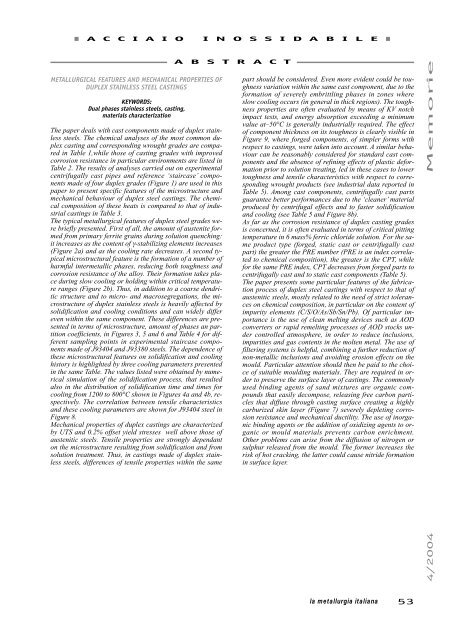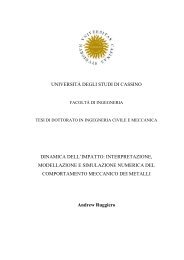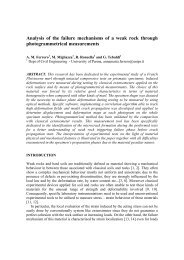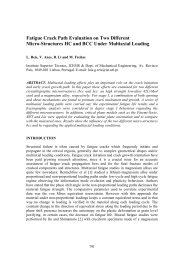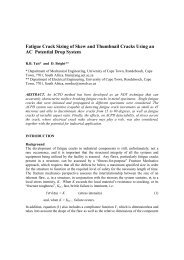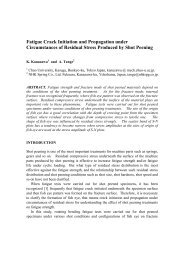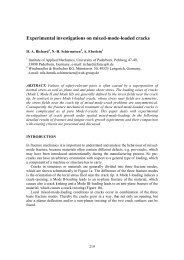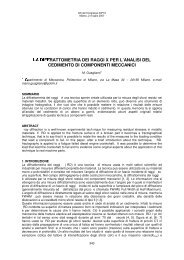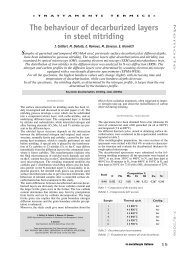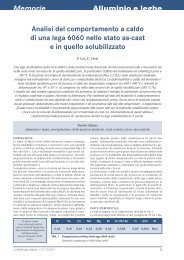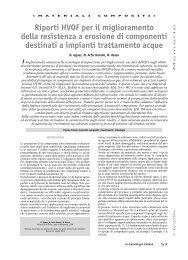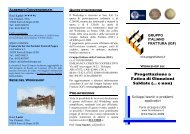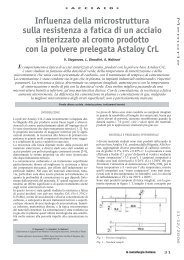Aspetti metallurgici e caratteristiche meccaniche in getti realizzati ...
Aspetti metallurgici e caratteristiche meccaniche in getti realizzati ...
Aspetti metallurgici e caratteristiche meccaniche in getti realizzati ...
You also want an ePaper? Increase the reach of your titles
YUMPU automatically turns print PDFs into web optimized ePapers that Google loves.
ACCIAIO INOSSIDABILE<br />
METALLURGICAL FEATURES AND MECHANICAL PROPERTIES OF<br />
DUPLEX STAINLESS STEEL CASTINGS<br />
KEYWORDS:<br />
Dual phases sta<strong>in</strong>less steels, cast<strong>in</strong>g,<br />
materials characterization<br />
The paper deals with cast components made of duplex sta<strong>in</strong>less<br />
steels. The chemical analyses of the most common duplex<br />
cast<strong>in</strong>g and correspond<strong>in</strong>g wrought grades are compared<br />
<strong>in</strong> Table 1,while those of cast<strong>in</strong>g grades with improved<br />
corrosion resistance <strong>in</strong> particular environments are listed <strong>in</strong><br />
Table 2. The results of analyses carried out on experimental<br />
centrifugally cast pipes and reference ‘staircase’ components<br />
made of four duplex grades (Figure 1) are used <strong>in</strong> this<br />
paper to present specific features of the microstructure and<br />
mechanical behaviour of duplex steel cast<strong>in</strong>gs. The chemical<br />
composition of these heats is compared to that of <strong>in</strong>dustrial<br />
cast<strong>in</strong>gs <strong>in</strong> Table 3.<br />
The typical metallurgical features of duplex steel grades were<br />
briefly presented. First of all, the amount of austenite formed<br />
from primary ferrite gra<strong>in</strong>s dur<strong>in</strong>g solution quench<strong>in</strong>g:<br />
it <strong>in</strong>creases as the content of γ-stabiliz<strong>in</strong>g elements <strong>in</strong>creases<br />
(Figure 2a) and as the cool<strong>in</strong>g rate decreases. A second typical<br />
microstructural feature is the formation of a number of<br />
harmful <strong>in</strong>termetallic phases, reduc<strong>in</strong>g both toughness and<br />
corrosion resistance of the alloy. Their formation takes place<br />
dur<strong>in</strong>g slow cool<strong>in</strong>g or hold<strong>in</strong>g with<strong>in</strong> critical temperature<br />
ranges (Figure 2b). Thus, <strong>in</strong> addition to a coarse dendritic<br />
structure and to micro- and macrosegregations, the microstructure<br />
of duplex sta<strong>in</strong>less steels is heavily affected by<br />
solidification and cool<strong>in</strong>g conditions and can widely differ<br />
even with<strong>in</strong> the same component. These differences are presented<br />
<strong>in</strong> terms of microstructure, amount of phases an partition<br />
coefficients, <strong>in</strong> Figures 3, 5 and 6 and Table 4 for different<br />
sampl<strong>in</strong>g po<strong>in</strong>ts <strong>in</strong> experimental staircase components<br />
made of J93404 and J93380 steels. The dependence of<br />
these microstructural features on solidification and cool<strong>in</strong>g<br />
history is highlighted by three cool<strong>in</strong>g parameters presented<br />
<strong>in</strong> the same Table. The values listed were obta<strong>in</strong>ed by numerical<br />
simulation of the solidification process, that resulted<br />
also <strong>in</strong> the distribution of solidification time and times for<br />
cool<strong>in</strong>g from 1200 to 800°C shown <strong>in</strong> Figures 4a and 4b, respectively.<br />
The correlation between tensile characteristics<br />
and these cool<strong>in</strong>g parameters are shown for J93404 steel <strong>in</strong><br />
Figure 8.<br />
Mechanical properties of duplex cast<strong>in</strong>gs are characterized<br />
by UTS and 0.2% offset yield stresses well above those of<br />
austenitic steels. Tensile properties are strongly dependant<br />
on the microstructure result<strong>in</strong>g from solidification and from<br />
solution treatment. Thus, <strong>in</strong> cast<strong>in</strong>gs made of duplex sta<strong>in</strong>less<br />
steels, differences of tensile properties with<strong>in</strong> the same<br />
ABSTRACT<br />
part should be considered. Even more evident could be toughness<br />
variation with<strong>in</strong> the same cast component, due to the<br />
formation of severely embrittl<strong>in</strong>g phases <strong>in</strong> zones where<br />
slow cool<strong>in</strong>g occurs (<strong>in</strong> general <strong>in</strong> thick regions). The toughness<br />
properties are often evaluated by means of KV notch<br />
impact tests, and energy absorption exceed<strong>in</strong>g a m<strong>in</strong>imum<br />
value at–50°C is generally <strong>in</strong>dustrially required. The effect<br />
of component thickness on its toughness is clearly visible <strong>in</strong><br />
Figure 9, where forged components, of simpler forms with<br />
respect to cast<strong>in</strong>gs, were taken <strong>in</strong>to account. A similar behaviour<br />
can be reasonably considered for standard cast components<br />
and the absence of ref<strong>in</strong><strong>in</strong>g effects of plastic deformation<br />
prior to solution treat<strong>in</strong>g, led <strong>in</strong> these cases to lower<br />
toughness and tensile characteristics with respect to correspond<strong>in</strong>g<br />
wrought products (see <strong>in</strong>dustrial data reported <strong>in</strong><br />
Table 5). Among cast components, centrifugally cast parts<br />
guarantee better performances due to the ‘cleaner’ material<br />
produced by centrifugal effects and to faster solidification<br />
and cool<strong>in</strong>g (see Table 5 and Figure 8b).<br />
As far as the corrosion resistance of duplex cast<strong>in</strong>g grades<br />
is concerned, it is often evaluated <strong>in</strong> terms of critical pitt<strong>in</strong>g<br />
temperature <strong>in</strong> 6 mass% ferric chloride solution. For the same<br />
product type (forged, static cast or centrifugally cast<br />
part) the greater the PRE number (PRE is an <strong>in</strong>dex correlated<br />
to chemical composition), the greater is the CPT, while<br />
for the same PRE <strong>in</strong>dex, CPT decreases from forged parts to<br />
centrifugally cast and to static cast components (Table 5).<br />
The paper presents some particular features of the fabrication<br />
process of duplex steel cast<strong>in</strong>gs with respect to that of<br />
austenitic steels, mostly related to the need of strict tolerances<br />
on chemical composition, <strong>in</strong> particular on the content of<br />
impurity elements (C/S/O/As/Sb/Sn/Pb). Of particular importance<br />
is the use of clean melt<strong>in</strong>g devices such as AOD<br />
converters or rapid remelt<strong>in</strong>g processes of AOD stocks under<br />
controlled atmosphere, <strong>in</strong> order to reduce <strong>in</strong>clusions,<br />
impurities and gas contents <strong>in</strong> the molten metal. The use of<br />
filter<strong>in</strong>g systems is helpful, comb<strong>in</strong><strong>in</strong>g a further reduction of<br />
non-metallic <strong>in</strong>clusions and avoid<strong>in</strong>g erosion effects on the<br />
mould. Particular attention should then be paid to the choice<br />
of suitable mould<strong>in</strong>g materials. They are required <strong>in</strong> order<br />
to preserve the surface layer of cast<strong>in</strong>gs. The commonly<br />
used b<strong>in</strong>d<strong>in</strong>g agents of sand mixtures are organic compounds<br />
that easily decompose, releas<strong>in</strong>g free carbon particles<br />
that diffuse through cast<strong>in</strong>g surface creat<strong>in</strong>g a highly<br />
carburized sk<strong>in</strong> layer (Figure 7) severely deplet<strong>in</strong>g corrosion<br />
resistance and mechanical ductility. The use of <strong>in</strong>organic<br />
b<strong>in</strong>d<strong>in</strong>g agents or the addition of oxidiz<strong>in</strong>g agents to organic<br />
or mould materials prevents carbon enrichment.<br />
Other problems can arise from the diffusion of nitrogen or<br />
sulphur released from the mould. The former <strong>in</strong>creases the<br />
risk of hot crack<strong>in</strong>g, the latter could cause nitride formation<br />
<strong>in</strong> surface layer.<br />
4/2004 Memorie<br />
la metallurgia italiana 53


